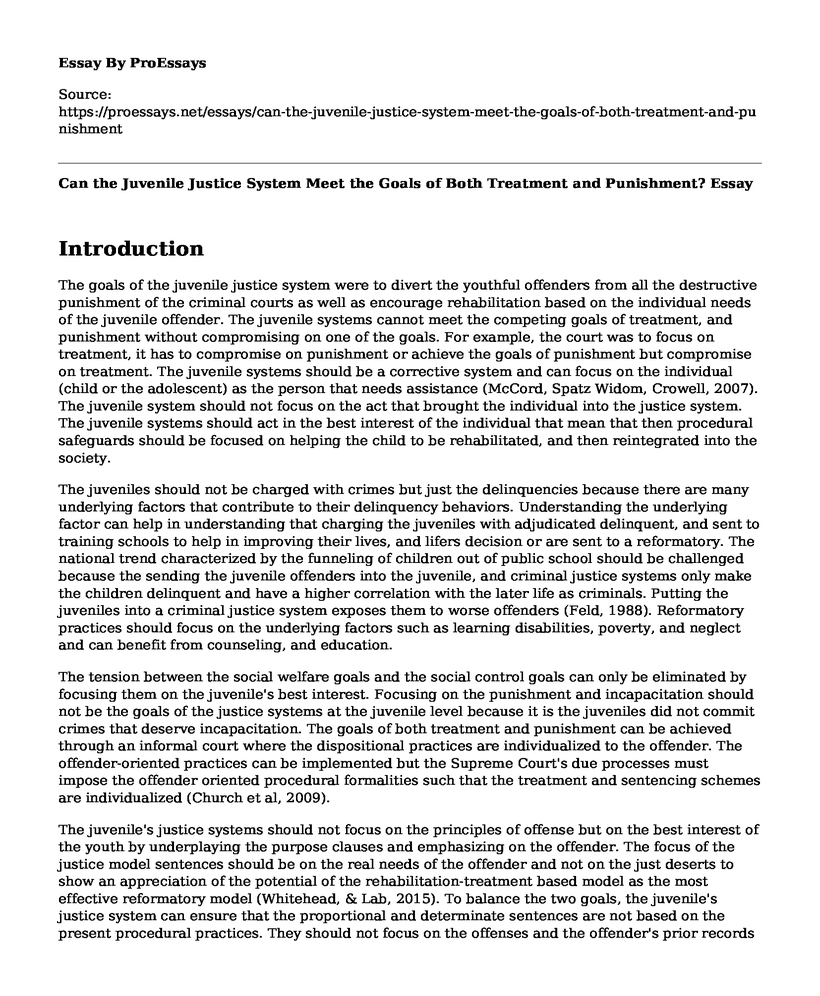Introduction
The goals of the juvenile justice system were to divert the youthful offenders from all the destructive punishment of the criminal courts as well as encourage rehabilitation based on the individual needs of the juvenile offender. The juvenile systems cannot meet the competing goals of treatment, and punishment without compromising on one of the goals. For example, the court was to focus on treatment, it has to compromise on punishment or achieve the goals of punishment but compromise on treatment. The juvenile systems should be a corrective system and can focus on the individual (child or the adolescent) as the person that needs assistance (McCord, Spatz Widom, Crowell, 2007). The juvenile system should not focus on the act that brought the individual into the justice system. The juvenile systems should act in the best interest of the individual that mean that then procedural safeguards should be focused on helping the child to be rehabilitated, and then reintegrated into the society.
The juveniles should not be charged with crimes but just the delinquencies because there are many underlying factors that contribute to their delinquency behaviors. Understanding the underlying factor can help in understanding that charging the juveniles with adjudicated delinquent, and sent to training schools to help in improving their lives, and lifers decision or are sent to a reformatory. The national trend characterized by the funneling of children out of public school should be challenged because the sending the juvenile offenders into the juvenile, and criminal justice systems only make the children delinquent and have a higher correlation with the later life as criminals. Putting the juveniles into a criminal justice system exposes them to worse offenders (Feld, 1988). Reformatory practices should focus on the underlying factors such as learning disabilities, poverty, and neglect and can benefit from counseling, and education.
The tension between the social welfare goals and the social control goals can only be eliminated by focusing them on the juvenile's best interest. Focusing on the punishment and incapacitation should not be the goals of the justice systems at the juvenile level because it is the juveniles did not commit crimes that deserve incapacitation. The goals of both treatment and punishment can be achieved through an informal court where the dispositional practices are individualized to the offender. The offender-oriented practices can be implemented but the Supreme Court's due processes must impose the offender oriented procedural formalities such that the treatment and sentencing schemes are individualized (Church et al, 2009).
The juvenile's justice systems should not focus on the principles of offense but on the best interest of the youth by underplaying the purpose clauses and emphasizing on the offender. The focus of the justice model sentences should be on the real needs of the offender and not on the just deserts to show an appreciation of the potential of the rehabilitation-treatment based model as the most effective reformatory model (Whitehead, & Lab, 2015). To balance the two goals, the juvenile's justice system can ensure that the proportional and determinate sentences are not based on the present procedural practices. They should not focus on the offenses and the offender's prior records in dictating the actual length as well as the location and the intensity of their type of intervention
Conclusion
In conclusion, there should be a shift from punishment to treatment by changing the dispositional decision-making processes. The procedural protection is not effective in achieving the treatment goals but only advances the punishment clause. Therefore, the juvenile justice system should establish a separate juvenile court system that affords the procedural processes because having the same procedural parity with that of the adults is clear a prelude for the juvenile punishment. Without a separate juvenile court system, the procedural protection in the juvenile court is not adequate for achieving the treatment goals but the punishment goals.
Reference
Whitehead J.T. and S. P. Lab. (2015). Juvenile Justice: An Introduction. 8th Edition. Routledge.
Church et al. (2009). What Do You Mean My Child Is in Custody? A Qualitative Study of Parental Response to the Detention of Their Child. Journal of Family Social Work - American Civil Liberties Union. "Locating the School to Prison Pipeline".
Feld, B. (1988). The Juvenile Court Meets the Principle of Offense: Punishment, Treatment, andthe Difference It Makes, 68
B.U. L. Rev. 821 available at http://scholarship.law.umn.edu/faculty_articles/285McCord, J, Spatz Widom, C, Crowell, N, (2007). Panel on Juvenile Crime: Prevention, Treatment, and Control, National Research Council (U.S.). Committee on Law and Justice, National Research Council (U.S.). Commission on Behavioral and Social Sciences and Education. National Academy Press.
Cite this page
Can the Juvenile Justice System Meet the Goals of Both Treatment and Punishment?. (2022, Jun 24). Retrieved from https://proessays.net/essays/can-the-juvenile-justice-system-meet-the-goals-of-both-treatment-and-punishment
If you are the original author of this essay and no longer wish to have it published on the ProEssays website, please click below to request its removal:
- Paper Sample on HIV Infection in Prisons
- Analysis of "The Lethal Effects of Three Strikes Laws" and "Three Strikes and You're Out"
- Essay Sample on Civil and Political Rights
- Research Paper on Female Crime: Education & School Quality Impact
- Essay Example on Youth Gangs in Canada: A Sociological Study on Causes and Risks
- Essay Example on Hong Kong-China Divide: Clash of Legal Systems
- Essay Exploring Direct Effect in the Context of European Union Law and International Treaties







